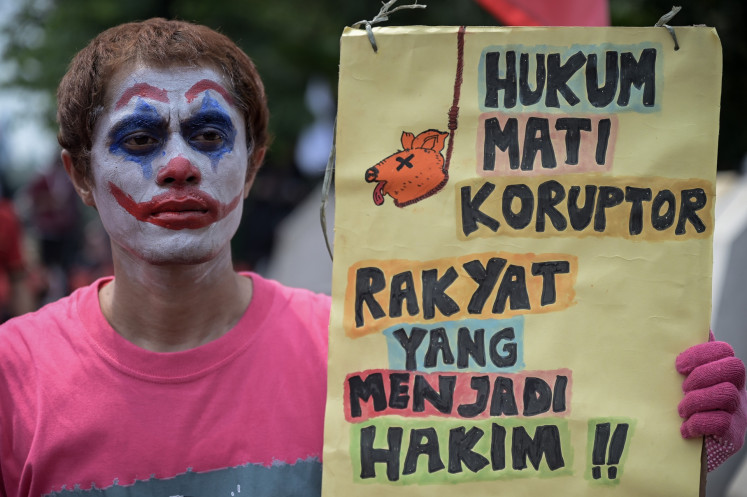Popular Reads
Top Results
Can't find what you're looking for?
View all search resultsPopular Reads
Top Results
Can't find what you're looking for?
View all search resultsIndividualized approach and programs not enough to fight HIV
Today, many people and institutions across the world observe International AIDS Day
Change text size
Gift Premium Articles
to Anyone
T
oday, many people and institutions across the world observe International AIDS Day. One of the most important aims of this commemoration is to reflect our successes and failures in fighting the epidemic in order to design and implement a more comprehensive approach and programs.
It is noteworthy that in most developed countries the spread of HIV is now relatively under control. In developing countries we can find numerous success stories as well, such as increasing awareness, knowledge and behaviors to protect individuals from HIV infection.
The levels of condom use, the initiation and development of harm-reduction programs such as needle and syringe exchange programs, drug substitution programs, relapse-prevention programs, overdose prevention programs, the increasing access to antiretroviral drugs and so on have increased in several cities in developing countries, including Indonesia.
However, studies indicate that HIV continues to spread particularly among vulnerable groups and among people from disadvantaged social and economic backgrounds. There is an increasing number of studies that maintain that there is a strong linkage between poverty, economic inequality and the HIV epidemic.
On one hand, poverty and economic inequality provide fertile ground for people’s engagement in HIV-related risk behaviors (having multiple sexual partners, low levels of condom use and the sharing of needles and other injecting equipment), while on the other HIV infection may further exacerbate poverty, economic inequality and individual and social suffering.
Unfortunately, despite the improvement of understanding of the social and economic context of HIV epidemic, so far the dominant approach and most programs to combat HIV and AIDS worldwide are still individualized approaches and individualized programs. These approaches and programs are known as the “knowledge and means model” and are based on the dominant theory of the “health belief model” which assumes that by merely by providing people with “knowledge” and “means” or “tools”, individuals will automatically protect themselves against HIV infection or avoid HIV-related risk behaviors.
These approaches and programs believe that by providing people with enough information on HIV and sufficient tools such as condoms and sterile needles, the rate of condom use will suddenly increase and rate of needle sharing will automatically decrease.
However, health sociologists and anthropologists frequently criticize these approaches and programs and label them as merely “technology of the body” that overlook the social context or assume that involvement in HIV-related risk behaviors takes place in a social vacuum and are a result of a gap in knowledge, attitudes and behaviors.
But studies and experience have shown that it is not the case, particularly among people from low social and economic backgrounds. It is much more difficult to increase the level of condom use among poor people who have multiple sex partners compared to people from higher economic backgrounds.
It is much more difficult to prevent poor drug injectors not to share unsterile needles and injecting paraphernalia compared to drug injectors from higher economic backgrounds.
Abundant research indicates that there are many risk factors that push people to be involved in HIV-risk behaviors and most of these are beyond individuals’ control. Numerous studies show that poor people face many barriers to employ safer behaviors and most of these barriers are beyond their control. While these individualized approaches and programs are necessary, they are not sufficient to combat the HIV epidemic because they tend to overlook and neglect the social and economic context of the epidemic.
Now there is an increasing awareness of the weaknesses of individualistic approaches and programs to health interventions and this has led to a growing debate and discourse on the need for and relevance of structural interventions that address distal- and proximal-risk factors of contemporary public health problems, including HIV.
Structural interventions focus on changing the context or environment within which individuals act for the purpose of persuading them to apply healthier and safer behaviors. In other words, structural interventions attempt to create an enabling environment, an environment that enables or empowers people to make positive preferences by providing them a supportive context, and provides them with sufficient opportunities to make healthier choices.
Structural interventions seek to “affect risk environments” by altering the context in which ill-health occurs. Such interventions address social and economic determinants of health and have the potential to affect multiple endpoints.
It should also be noted that structural interventions are consistent with the principles of the “new public health” as presented in the Ottawa Charter for Health Promotion, which explicitly advocates the need to address social and environmental determinants of health and advocates the need to develop effective responses to public health issues both at individual and community levels.
In addition, numerous studies have revealed the relevance of and the need for structural interventions in the field of HIV prevention. Studies maintain that structural interventions for HIV prevention should focus on three areas of change.
First, by addressing social change, this approach focuses on factors affecting multiple groups (e.g. a region or country as a whole), such as legal reform, socioeconomic empowerment and stigma-reduction for marginalized groups, and efforts to cultivate strong leadership on HIV and drug use prevention programs.
Second, by promoting changes within specific groups, this approach addresses social structures that create vulnerability among specific populations, such as problematic drug users, drug injectors, sex workers, homosexuals and poor young people, poor girls and homeless people.
Examples include efforts to organize and empower problematic drug users, drug injectors, sex workers, including microfinance programs for poor people as well as interventions to change harmful local norms.
Third, harm-reduction and health-seeking behavior change, with approaches that focus on making harm-reduction programs available to those in need, and to change rules, services and attitudes that impede access to these programs. Examples include efforts to provide education employment and safe housing for poor people and vulnerable groups.
In order to promote the initiation of structural interventions to combat the HIV epidemic, we should view HIV not merely as a medical or public heath issue. We should see it in the framework of broader development issue.
A multidisciplinary approach and the involvement of researchers and peoples from different background such as economics, psychology, sociology, anthropology, social work, community development and so on are highly needed.
The writer, who earned his doctoral degree at the Melbourne School of Population Health at the University of Melbourne, Australia, is a lecturer and researcher at the School of Public Health, Hasanuddin University, Makassar.










